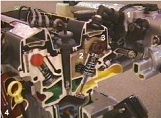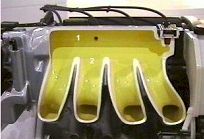The Engine Top End
Note: This content is directly from our Road Machines Educational CD, available for purchase and download instantly in our store.
General:
 An engine's top end is designed to combine air and fuel in the correct ratio and deliver the mixture to the combustion chambers. The top end also provides a means for combustion gases to exit the engine. The top end consists of four major components: intake manifold (1), cylinder head (2), valve train (3), and exhaust manifold (4).
An engine's top end is designed to combine air and fuel in the correct ratio and deliver the mixture to the combustion chambers. The top end also provides a means for combustion gases to exit the engine. The top end consists of four major components: intake manifold (1), cylinder head (2), valve train (3), and exhaust manifold (4).
Intake Manifold:
 The intake manifold (1) distributes air to each cylinder. Intake runners (2) connect each intake port to the manifold. Piston action creates a vacuum in the manifold, which draws outside air through the throttle body and into the manifold. The vacuum will increase when the throttle valve closes (air flow is restricted) and will decrease when the throttle valve opens (air flow is less restricted.) Diesel engines do not have a throttle valve, therefore the vacuum in the manifold is weaker than a gasoline engine.
The intake manifold (1) distributes air to each cylinder. Intake runners (2) connect each intake port to the manifold. Piston action creates a vacuum in the manifold, which draws outside air through the throttle body and into the manifold. The vacuum will increase when the throttle valve closes (air flow is restricted) and will decrease when the throttle valve opens (air flow is less restricted.) Diesel engines do not have a throttle valve, therefore the vacuum in the manifold is weaker than a gasoline engine.
Vacuum:
A vacuum is pressure that is below atmospheric pressure. Systems such as power brakes, emission control, fuel, and cabin ventilation use manifold vacuum to operate components. Some examples include the power brake booster, EGR valve, and fuel pressure regulator. Since Diesel engines produce a weak vacuum, an engine-driven vacuum pump is provided to generate the necessary vacuum for systems requiring it.
Manifold Pressure:
Manifold pressure is a good indicator of engine load. Pressure sensing, electronic multi-point fuel injection systems have a sensor that provides manifold pressure feedback to the engine's computer. A high pressure signal indicates a high load requiring a rich mixture. A low manifold pressure signal indicates reduced load requiring a leaner mixture. The computer will lengthen fuel injection pulse time to richen the mixture. For a leaner mixture, the computer will shorten pulse time.


